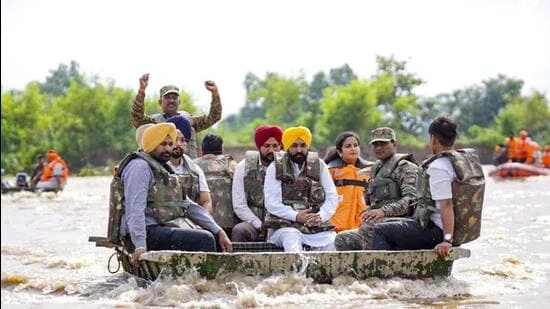When the rains came to Punjab in August-September, they came with an intensity that the state had not seen in decades. Torrents poured down over the upper catchments, rivers swelled beyond their banks, and reservoirs strained at their limits.
Within days, water had engulfed the countryside: More than 1,650 villages across all 23 districts were affected, over 1.75 lakh acres of farmland lay submerged, and at least 46 human lives had been lost. By the government’s estimate, the overall damage touched a staggering ₹20,000 crore.
In the immediate aftermath, the familiar chorus of blame began. The Punjab government was accused of poor planning and weak flood management. But such criticisms tell only half the story. To understand why Punjab continues to suffer so grievously from floods, one has to look beyond the rains and into the structures of water governance – the structures that leave the state paying the heaviest price, while others enjoy the benefits.
Floods in Punjab are not simply the result of nature’s fury. Their severity is shaped by how water is stored and released from the reservoirs that straddle the state. On paper, the answer seems simple: Release water in time to prevent sudden overflow. In practice, Punjab does not hold the reins. Decisions on releases from Bhakra, Pong and other reservoirs are taken not by Punjab alone but by joint technical committees where all beneficiary states sit. These include Haryana and Rajasthan. Their representatives, particularly from Rajasthan, frequently oppose early releases. Their logic is that discharging water prematurely will shrink the pool available to them later in the season for drinking, agriculture and industry.
This year, Punjab had warned of a heavy monsoon and sought higher releases of 29,500 cusecs in early June to lower the risk of flooding. What was permitted was only 21,607 cusecs. When heavy rains followed, the water overtopped the reservoirs and spilled into Punjab’s fields and villages. Other states continued to safeguard their shares, while Punjab was left to cope with the devastation. The benefits of storage were collective, but the costs of floods were concentrated in Punjab. The state was also responsible to maintain aging water regulation infrastructure requiring huge investments.
Outdated guidelines
The Punjab government announced a relief package that went well beyond what the national disaster relief framework permits. Farmers were promised ₹20,000/acre for crop damage, silted fields would be compensated at ₹7,200/acre, houses that were fully destroyed would receive ₹1.2 lakh, those partially damaged ₹40,000, and families who had lost members were assured ₹4 lakh each. Loan repayments for farmers were deferred for six months without additional interest. These measures reflected the government’s attempt to respond to human suffering, but they also highlighted how far the existing national norms fall short of reality.
Much of the public debate has been clouded by the claim that Punjab has either lost or misused disaster relief funds estimated at ₹12,589 crore. The facts prove otherwise.
Punjab, like all states, receives allocations every year for the State Disaster Response Fund. These funds, recommended by the finance commission, are non-lapsable, meaning that they do not disappear if unspent in a given year. Three-fourths of the money is provided by the Centre, the rest by the state. The funds are available, though the amount changes over time. What constrains their use are outdated guidelines, and spending norms.
The compensation amounts fixed by the Government of India decades ago are woefully out of touch with present-day prices. A farmer who loses an acre of paddy worth ₹50,000 may receive as little as ₹7,000. A family whose house is destroyed may be entitled to only ₹95,000, when rebuilding can easily run into lakhs. In such circumstances, state governments are forced to announce higher packages from their own budgets.
Here another difficulty arises: Punjab, like most states, manages its finances through tight cash flows. It must meet salaries, health and education needs, debt repayments and infrastructure commitments. Even when disaster relief funds exist on paper, the actual release of cash depends on balancing multiple competing demands. The perception that the state is slow in disbursing aid is not always evidence of negligence, but of fiscal stress.
Three urgent lessons
The 2025 floods highlight three urgent lessons. First, disaster relief norms must be updated to reflect the actual costs of crops, houses and livestock today, not the prices of decades past. Second, the costs of managing floods must be shared among all states that benefit from Punjab’s waters. It is unreasonable to expect Punjab alone to carry the burden of loss, while others reap the benefits of security. Third, the Government of India must establish a contingency mechanism for immediate, flexible support in times of disaster, free of the bureaucratic delays.
Punjab’s tragedy is not an isolated misfortune, nor is it a story of administrative failure alone. It is the consequence of a structural imbalance in how India manages its rivers, its water storage, and its disasters. Year after year, Punjab provides water security to others, but in return it is left with disaster insecurity for itself.
The truth is not that funds have been misused – they are secure. The truth is not that mismanagement alone caused the floods – the decisions were collective. The truth is that the burdens of disaster are unevenly distributed, the norms outdated, and the relief mechanisms inadequate.
Floods, ultimately, are not just Punjab’s problem. They are a national issue, demanding national fairness. If the benefits of water are to be shared across states, then the burdens of floods must be shared as well.
The monsoon of 2025 should not just be remembered for its destruction, but also as a call to finally correct this imbalance. [email protected]

